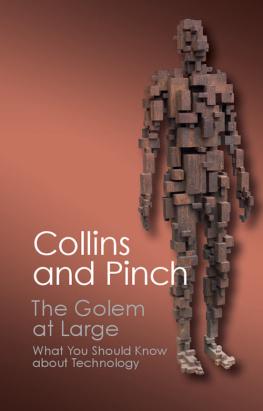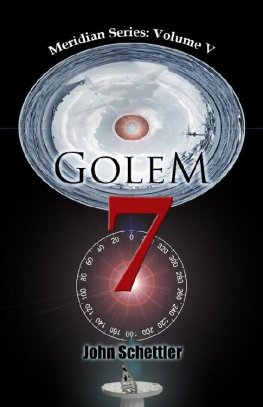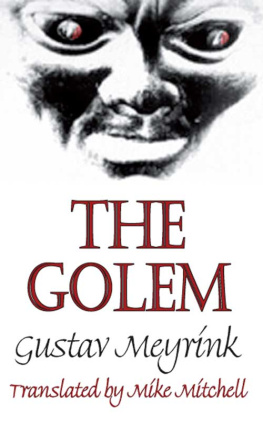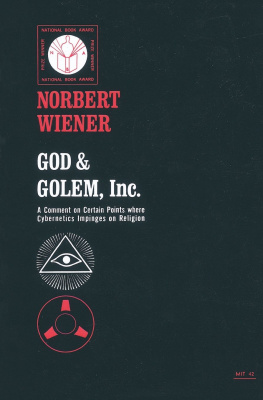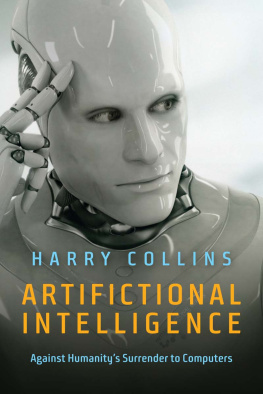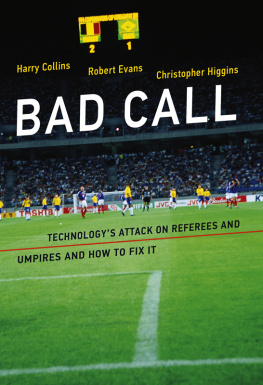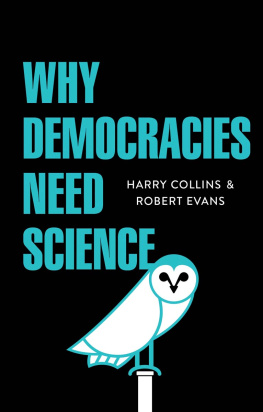Collins Harry - Golem at Large : What You Should Know About Technology
Here you can read online Collins Harry - Golem at Large : What You Should Know About Technology full text of the book (entire story) in english for free. Download pdf and epub, get meaning, cover and reviews about this ebook. year: 2014, publisher: Cambridge Univ Pr, genre: Science. Description of the work, (preface) as well as reviews are available. Best literature library LitArk.com created for fans of good reading and offers a wide selection of genres:
Romance novel
Science fiction
Adventure
Detective
Science
History
Home and family
Prose
Art
Politics
Computer
Non-fiction
Religion
Business
Children
Humor
Choose a favorite category and find really read worthwhile books. Enjoy immersion in the world of imagination, feel the emotions of the characters or learn something new for yourself, make an fascinating discovery.
- Book:Golem at Large : What You Should Know About Technology
- Author:
- Publisher:Cambridge Univ Pr
- Genre:
- Year:2014
- Rating:5 / 5
- Favourites:Add to favourites
- Your mark:
- 100
- 1
- 2
- 3
- 4
- 5
Golem at Large : What You Should Know About Technology: summary, description and annotation
We offer to read an annotation, description, summary or preface (depends on what the author of the book "Golem at Large : What You Should Know About Technology" wrote himself). If you haven't found the necessary information about the book — write in the comments, we will try to find it.
Golem at Large : What You Should Know About Technology — read online for free the complete book (whole text) full work
Below is the text of the book, divided by pages. System saving the place of the last page read, allows you to conveniently read the book "Golem at Large : What You Should Know About Technology" online for free, without having to search again every time where you left off. Put a bookmark, and you can go to the page where you finished reading at any time.
Font size:
Interval:
Bookmark:



FOR SADIE COLLINS
AND TO THE MEMORY OF OWAIN PINCH
With the exception of most of , the substantive parts of this book are largely expositions of others work; in this we follow the pattern of the first volume in the Golem series. The full bibliographic references to the works discussed both in this Preface and the other chapters, as well as additional reading, will be found in the Bibliography at the end of the volume.
As for the substantive chapters, of reaching any firm conclusion while keeping open the strong possibility that Postol is right.
is based on parts of Diane Vaughan's book, The Challenger Launch Decision: Risky Technology, Culture and Deviance at NASA . In the context of earlier work, Pinch had previously read McConnell's book, Challenger: A Major Malfunction, Report of the Presidential Commission on the Space Shuttle Challenger Accident and Gieryn and Figert's article, Ingredients for a Theory of Science in Society. An earlier article by Pinch on this topic can be found in the Bibliography, but Vaughan's meticulous research provides a detailed historical ethnography of the events leading up to the Challenger launch decision and leads to a new interpretation of them.
is an exposition and simplification of one of Collins's own papers, Public Experiments and Displays of Virtuosity: The Core-Set Revisited which is referred to in the Bibliography.
is based on Simon Cole's article, Which Came First, the Fossil or the Fuel? This article was originally prepared as a term paper for a course taught by Pinch at Cornell University. Pinch also has access to an unpublished article by Cole on the Gold affair. We thank Bill Travers and Bill Travers Jr. for reading an earlier draft of the chapter.
The substantive part of doctoral student at the University of Bath between 1992 and 1995, working under his supervision. The Soothsaying or Science paper is based on this PhD, which is referred to in the Bibliography.
It should not be thought that all economists are unaware of the problems and ironies of their own discipline as the books by Ormerod and Wallis reveal. The Reports of the British Government's Panel of Independent Forecasters (The Seven Wise Men) for February 1993 and February 1994 were also an important source of information for the chapter. Collins also used ideas from his own The Meaning of Replication and the Science of Economics.
It should be noted that the Discussion and Postscript sections of , which include some speculations, are essentially the responsibility of the authors of this volume though most of the sceptical quotations are taken from economists.
For , Pinch used several articles by Brian Wynne on the effect of Chernobyl radiation on Cumbrian sheepfarmers. These articles are referred to in the Bibliography.
is based upon Pinch's reading of Steven Epstein's book Impure Science: AIDS, Activism and the Politics of Knowledge and an article, The Construction of Lay Expertise.
In the case of all chapters, both Pinch and Collins read and reworked the drafts and take joint responsibility for the results.
We are extremely grateful for the generosity and the efforts of the authors of the works on which we have based our accounts. In every case they were unstinting with their time and effort and, by reading our versions of their work, helped us make sure that we did not stray too far from their intentions. Wiebe Bijker and Knut Sorensen read and advised on the Introduction and the Conclusion. We thank Park Doing for suggesting the words at Large in our title. That said, the final responsibility for mistakes in exposition, infelicities of style, and errors of judgement or analysis, remains our own.
Science seems to be either all good or all bad. For some, science is a crusading knight beset by simple-minded mystics while more sinister figures wait to found a new fascism on the victory of ignorance. For others it is science which is the enemy; our gentle planet, our slowly and painfully nurtured sense of right and wrong, our feel for the poetic and the beautiful, are assailed by a technological bureaucracy the antithesis of culture controlled by capitalists with no concern but profit. For some, science gives us agricultural self-sufficiency, cures for the crippled, a global network of friends and acquaintances; for others it gives us weapons of war, a school teacher's fiery death as the space shuttle falls from grace, and the silent, deceiving, bone-poisoning, Chernobyl.
Both of these ideas of science are wrong and dangerous. The personality of science is neither that of a chivalrous knight nor pitiless juggernaut. What, then, is science? Science is a golem.
A golem is a creature of Jewish mythology. It is a humanoid made by man from clay and water, with incantations and spells. It is powerful. It grows a little more powerful every day. It will follow orders, do your work, and protect you from the ever threatening enemy. But it is clumsy and dangerous. Without control a golem may destroy its masters with its flailing vigour; it is a lumbering fool who knows neither his own strength nor the extent of his clumsiness and ignorance.
A golem, in the way we intend it, is not an evil creature but it is a little daft. Golem Science is not to be blamed for its mistakes; they are our mistakes. A golem cannot be blamed if it is doing its best. But we must not expect too much. A golem, powerful though it is, is the creature of our art and our craft.
This extract from the first volume of the series, The Golem: What You Should Know About Science , explains why we chose a golem as our motif. Now we turn from science to its applications; things are not so different.
Font size:
Interval:
Bookmark:
Similar books «Golem at Large : What You Should Know About Technology»
Look at similar books to Golem at Large : What You Should Know About Technology. We have selected literature similar in name and meaning in the hope of providing readers with more options to find new, interesting, not yet read works.
Discussion, reviews of the book Golem at Large : What You Should Know About Technology and just readers' own opinions. Leave your comments, write what you think about the work, its meaning or the main characters. Specify what exactly you liked and what you didn't like, and why you think so.

